- Key tip: Use the lightest jig you can while still feeling bottom contact (often 1/16–1/8 oz in <20′). A lighter jig gives more action and sensitivity.
- Tip: When you feel even a slight resistance or thump, set the hook firmly.
- Tip: This method works effectively from both boat and shore.
How to Catch Walleye: Complete Guide to Techniques, Gear, and Locations
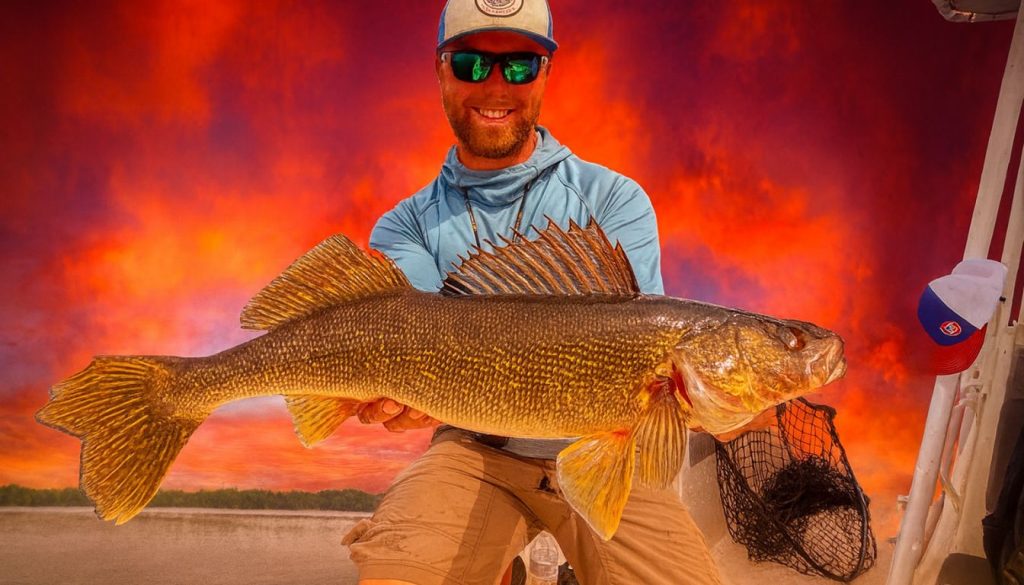
Species Profile
Walleye (Sander vitreus) is a freshwater percid fish native to the northern U.S. and Canada. It’s also called walleyed pike, yellow pikeperch, yellow pickerel (and locally Jack, dory, etc.). Adults have an olive-green to golden-brown back and sides fading to a white belly, often with 5–9 darker saddle-like bands. Distinctive features include two dorsal fins (the first with strong spines) with a black spot on the first dorsal, and a forked tail whose lower lobe has a white tip. The mouth is large with sharp canine teeth. In size, walleyes typically run 14–30 inches long (35–75 cm) and 1–10 pounds, females generally larger. The world record walleye was about 42 inches (107 cm) and ~25–29 pounds, though most anglers catch walleyes 12–20 inches.
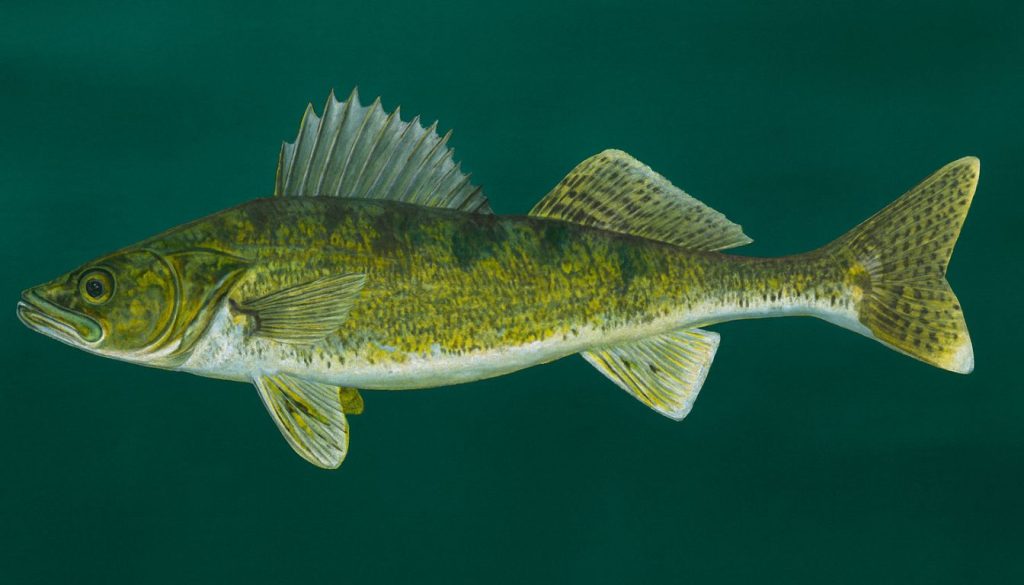
Why Target This Species
Walleyes are prized by anglers for both sport and table fare. They are known for exceptionally tasty, flaky white flesh and are regarded as a delicacy.
As predators with keen low-light vision, walleyes can be challenging to catch, so they’re generally a moderate (intermediate) target – not the easiest like bluegills, but not the hardest either. Anglers often rate them as an Intermediate/Advanced pursuit, requiring finesse with light bites and knowledge of their habits.
The best times to catch walleyes are spring (post-spawn) and fall, when fish concentrate in feeding areas. They feed aggressively in cooler water and low-light conditions. In many regions (e.g. Minnesota), walleye fishing is best late afternoon or night, especially on windy days (“walleye chop”) which stir up the water and trigger feeding.
In short, target walleyes in spring and fall or on overcast, windy evenings; be prepared for subtle strikes.
Behavior and Feeding
Hunting Pattern
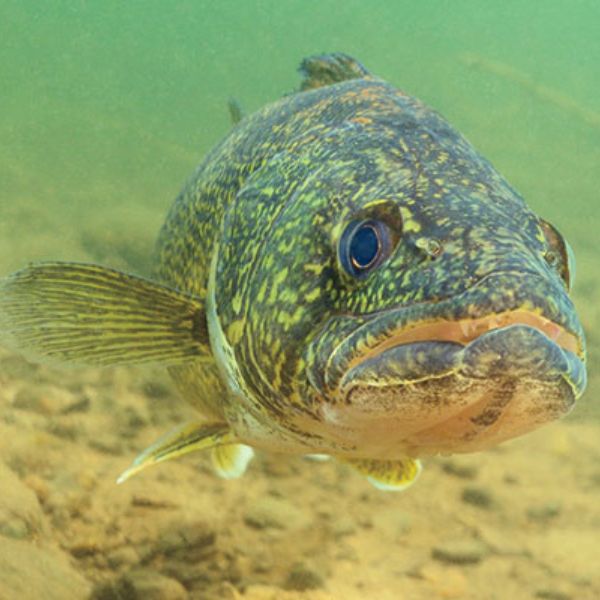
Walleyes are crepuscular/nocturnal ambush predators. Their large, cloudy eyes (with a reflective tapetum) give them excellent low-light vision, so they hunt by sight in dawn, dusk or stained water.
By day, walleyes typically stay near the bottom (benthic) and often group loosely near structure – rocky points, gravel bars, submerged timber or bridge pilings are common daytime hangouts.
At night or in low light they move shallower into open water (becoming pelagic), prowling for baitfish under cover of darkness. In short, walleyes tend to school quietly by day in cover and strike actively by night. They stalk or ambush prey rather than filter-feed; many bites happen as baits fall back toward the bottom.
Primary Diet
Walleye Diet Guide
Understanding what walleyes eat to catch more fish
🔄 Diet Evolution by Age
Small Schooling Fish
Bottom Dwellers
Nightcrawlers & Worms
🎣 Top Live Baits for Walleye
Because of their natural diet, the most effective baits match what walleyes hunt daily. These three live baits consistently outperform others and draw strikes even when walleyes are finicky:
(or Shiners)
(Worms)
Pro Rigging Technique
In practice, anglers tip jigs or hook rigs with minnows or leeches to perfectly imitate the walleye's usual forage. This combination of artificial action with natural scent and movement is devastatingly effective for triggering strikes from even pressured fish.
🎨 Best Artificial Lures
The walleye's diet explains why certain lure types consistently produce results. Focus on presentations that mimic their primary prey:
Where and When to Find Them
Key Habitat
In the U.S., walleyes are most abundant in the northern states, especially around the Great Lakes and Mississippi River basins. Famous fisheries include Lake Erie (Ohio), Saginaw Bay (Lake Huron), Lake Winnebago (WI), Lake of the Woods (MN), and many reservoir/river systems like the Mississippi, Missouri, and Ohio rivers.
Preferred habitats have cool, well-oxygenated water and structure. Typical spots include rocky reefs, gravel points and shoals, submerged humps or ledges, and river channels or drop-offs. Cover such as weeds, timber or piers also hold walleyes.
They favor moderate depths that change with season: shallow flats or river mouths in spring; deeper troughs, holes or river pools in summer; then flats and points again in fall. Water clarity varies – walleyes tolerate stained water (hence windy “chop”), but clear lakes are also loaded.
In short, focus on structured water (points, bars, weedlines) with nearby deep refuge – for example, walleyes often cruise weed breaks or rocky drop-offs.
Fishing Calendar
Walleyes move seasonally. They spawn in spring when water hits roughly 6–10 °C (43–50 °F), usually March–April depending on latitude. During the spawn and immediately after, walleyes stay shallow over gravel or rocky bottoms to lay eggs. After spawning, they disperse to feeding areas.
In summer, many migrate to deeper, cooler water and are often found near thermoclines, cooler river mouths or shaded deep structure. By fall (September–November), cooling water brings walleyes shallow again, fattening up on schools of baitfish. This fall period often rivals spring as a peak bite time.
🐟 Walleye Seasonal Movement Calendar
Follow the migration patterns to find trophy walleyes year-round
🌡️ Water Temp: 43–50°F (6–10°C) triggers spawn
🎯 Strategy: Target spawning areas during and immediately after spawn; fish disperse to feeding areas post-spawn
🌡️ Water Temp: Seek comfortable 50–60°F zones
🎯 Strategy: Go deep with vertical jigging or trolling; focus on temperature breaks and structural edges
🌡️ Water Temp: Cooling water triggers feeding frenzy
🎯 Strategy: Target baitfish schools in shallows; walleyes fattening up for winter create exceptional bite
❄️ North: May go dormant in deepest pools under ice
🌊 Open Water: Can still feed actively through winter nights
🎯 Strategy: Ice fishing in northern regions; deep jigging in open water areas
Summer: Deep (thermoclines & cool structure)
Fall: Shallow (feeding frenzy on baitfish)
Winter: Deep (dormant in far north; active nights in open water)
Spawn Trigger: 43–50°F (6–10°C)
⚠️ Activity Drop: Outside 50–60°F range, feeding activity typically decreases
While spring and fall are prime, walleyes can be caught year-round with proper techniques. Adjust your depth and presentation based on water temperature and seasonal patterns for consistent success!
In the far north, ice formation slows feeding (walleyes may go dormant in deepest pools), but in open water regions they can still feed through winter nights.
A handy summary: shallow spring/fall, deep summer, deep winter (if present). Calendar-wise, year-round effort can pay off, but spring and fall are prime. A key temperature threshold is around 50–60°F; below or above that range their activity can drop.
Optimal Conditions
Walleyes thrive under low-light and certain weather conditions. They bite best at dawn, dusk and night – virtually any period of subdued light. Windy or overcast weather often triggers feeding: waves stir up bottom in shallow areas, making walleyes bolder (anglers call this the “walleye chop”). Indeed, fishing into a wind or fishing offshore bars in a breeze is productive.
Barometric trends also matter: stable or falling barometers (approaching storms) can enhance bites. Conversely, bright sunny days or a high noon sun tend to slow walleyes – they seek deeper cover then.
Ideal conditions are a steady breeze with cool water (50–70°F) and diffuse light. In windy conditions, focus on wind-blown points and shorelines; on cloudy days, be ready any time. (Tides are irrelevant in freshwater lakes.)
Remember, clear water calls for natural lure colors, while stained water lets you pull brighter/chartreuse patterns – walleyes are visual hunters even in dim light.
Gear and Techniques
Recommended Setup
Primary Gear: A 6½–7′ medium-action rod with a sensitive, fast tip is ideal for casting jigs or cranks. Pair it with a 2500–3000 size spinning reel and spool with 8–12 lb monofilament or thin braided line (often with an 8–12 lb fluorocarbon leader). This outfit is light enough to feel a walleye’s delicate bite yet strong enough to set hooks and control fish. Many experienced anglers prefer graphite rods for added sensitivity. This setup works well for most walleye techniques (jigging, casting, slip bobbers).
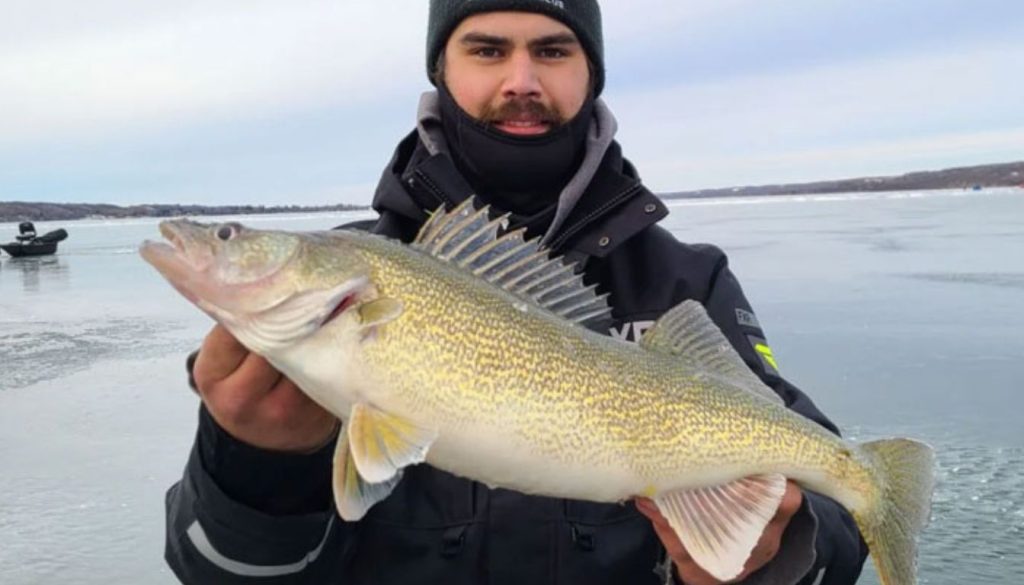
Alternative Gear: In situations with big fish or deep water, upsize gear. For example, use a 7–7½′ medium-heavy rod with a larger reel (3000–4000 size) and 15–20 lb braid (or 10 lb braid with heavy fluorocarbon leader) to handle heavy crankbaits and deep-trolling weights. Some anglers use a dedicated trolling rig (often 4–6 oz casting rods with 20–30 lb line or lead-core line) to reach 20+ ft depths on big lakes. Heavier gear sacrifices a bit of bite feel but helps land trophy walleyes.
For river or shore fishing, light slip-float rigs or 6–8 lb gear can be very effective too.
Effective Baits and Lures
Top 3 Natural Baits: Live bait often out-catches artificials for walleyes. The three go-to baits are:
- Minnows: Fathead, shiners or chubs hooked through the lips or dorsal/back and fished on a jighead or slip-sinker rig. Large minnows (3–4″) draw big walleyes, especially in fall. Rig them on 1/16–1/4 oz jigheads and cast or drift them just above bottom. Under a float, minnows will suspend at a set depth, perfect for fishing bars and drop-offs.
- Leeches: Ribbon leeches (not crayfish leeches) are deadly year-round. Pin one through a VMC or Trokar hook on a 1/16–1/8 oz jig or on a split-shot rig. Their movement is enticing in open water. Leeches especially shine in stained water or low-light.
- Nightcrawlers (worms): Thread nightcrawlers (or perch worms) on jig hooks or a multi-hook “crawler harness.” Worms work well when walleyes are deeper or colder (spring/fall). They have high visibility and swim naturally in the current. Worms are a great pike-safe choice in waters with northern pike.
Essential Lures: Modern lures are very effective for walleyes, especially when they imitate the forage above. The top categories are:
- Jigs & Soft Plastics: By far the #1 choice. Use 1/16–1/4 oz jigheads tipped with curly-tail grubs, paddle-tail minnows, or hair jigs. For example, a 1/8 oz chartreuse jig with a white grub is classic. Soft plastics on jigs add action and versatility (vertical jigging, casting + hopping, snap-jigging). Always match the jig size to the bait: small (1/16–1/8 oz) for small plastics or bait in clear water, larger (1/4 oz) for bigger lures or deeper water.
- Crankbaits & Jerkbaits: These mimic baitfish and excel for trolling or casting along flats and drop-offs. Long-bodied minnow-style lures (Rapala Husky Jerks, Rebel Minnows) are popular. Use floating or shallow-diving models early, and deep-divers (6–20 ft) later in summer. Color matters: natural shad/sunfish patterns in clear water, and brighter combos (white/chartreuse) in murky conditions. Crankbaits are especially potent when covering water or mapping fish.
- Blades/Spoons/Spinners: Blade baits (e.g. Swedish Pimple, VMC Hypnotic) and spoons work great, especially in cold water or deeper fish. They can be vertical-jigged or cast and retrieved. Inline spinners (Mepps, Blue Fox, or wobble rigs) with a small trout magnet are also classic walleyes baits that flash and vibrate like a fleeing minnow. In short, any lure that looks or moves like a small fish or crawdad can entice walleyes.
For lure color, white and bright contrasts work at most depths. (Red loses visibility deep, green/blue disappear first.) Many anglers swear by chartreuse-and-white as an all-around combo. In low light or stained water, glow-in-the-dark or bright colors can trigger strikes; in clear water, more natural hues are best.
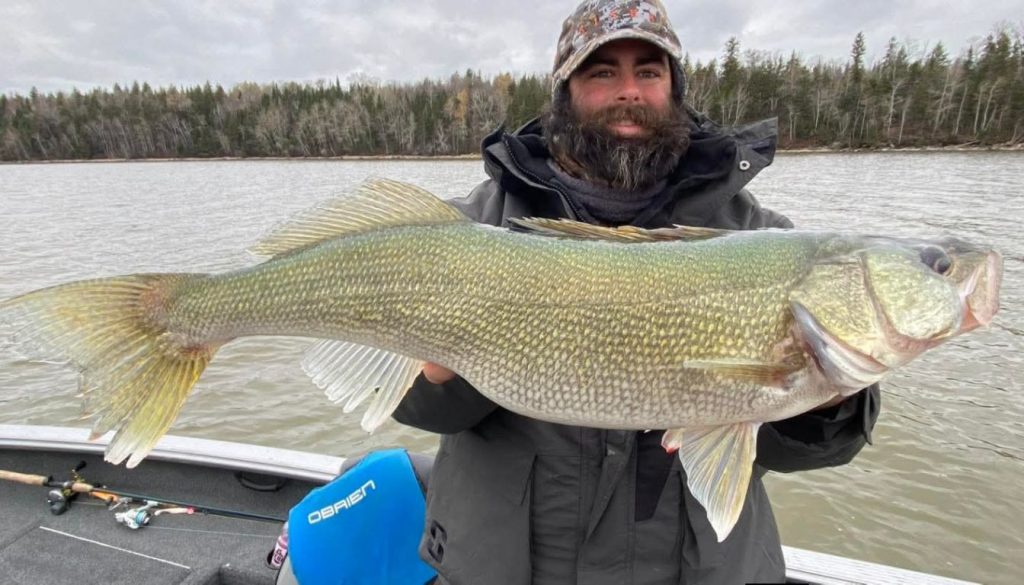
Fishing Techniques
Jigging (Bottom Bouncing)
This is the most versatile method. Find structure or drop-offs with your sonar. Cast or drop your jig or bait to the bottom and let it sink. Then retrieve with a “hop-hop-pause” action: lift the rod tip a few inches and then let the jig fall back to the bottom. Walleyes often strike on the fall, so keep your line tight and watch for a pull as the jig drops. If there’s no bite, drag the jig slowly or make small twitches.
Slip-Bobber and Bottom Rigs
Especially in rivers or when walleyes are lying just off bottom, use a sliding sinker or slip-float rig with live bait such as minnows or leeches. Cast it out, let it settle near bottom, and drift naturally with the current or wind. Watch your bobber for subtle twitches. This is a great way to cover shallow flats and present the bait at the exact depth of the fish.
Trolling
On large lakes, trolling is very effective. Rig crankbaits or spinner rigs at varying depths using planer boards or downriggers and troll parallel to shorelines or around structure. This covers water to find active fish. Use downriggers or lead-core line to reach the depths where walleyes school in summer. Fast trolling (3–4 mph) can locate fish; once found, stop and switch to jigging for hookups.
Snap-Jigging
A dynamic technique is snap-jigging: cast a heavy jig (metal or plastic) or spoon out, let it sink, then snap the rod up sharply and reel the slack repeatedly. This imparts a fast, erratic action on the bait and can trigger strikes from lurking walleyes. As with vertical jigging, many strikes come as the bait falls after each snap. This works well along wrecks and stumps.
Covering Spots
Always be ready to move. If one spot goes quiet after a few minutes, reel in and try the next point, break, or weedline. Walleye bites can be fickle; try a few casts of deadstick (letting bait sit) followed by jigging. Use electronics to note drop-offs and follow the contour of the bottom.
Pro Tips
- Tip: Be patient and attentive. Walleyes often bite slowly, so watch and feel the line carefully.
- Tip: Many walleyes grab the bait very gently or only as it drops. A light strike indicator can help, or feel for even a slight weight.
- Tip: On windy days, fish on the windblown side of points and flats.
- Tip: Vary lure color and size if fish won’t bite; sometimes a smaller-profile lure or more subtle color triggers bites.
- Tip: In bright conditions, slower presentations (dead sticks) can out-fish constant jigging – walleyes will sometimes lazily pick up a sitting bait.
- Tip: When hooked in weeds, pull steadily; walleyes are prone to foul-hooking.
- Tip: Keep extra leaders and hook sizes on hand – switching from a #4 to #6 hook or adding a short fluorocarbon leader can make all the difference.
Catch and Handling
During the Fight
Walleyes are not known for long, hard fights – in fact, on a pound-for-pound scale they are among the weakest fighters (often rated ~2/10). They tend to make slow headshakes and do not put up dramatic runs. This means you can often use lighter gear and still land them. The key is to detect the bite early.
With a walleye hooked, avoid overwhelming drag – maintain moderate pressure so the fish won’t bury instantly or pop the hook. Keep your line straight and use your rod tip to soften any headshakes. Many anglers make the mistake of yanking too hard at the strike (walleyes have soft mouths) – instead, sweep a firm but smooth hookset when you feel the weight.
Once hooked, walleyes will often dive for weeds or structure; do not jerk too hard, or the line may foul. Instead, apply steady upward pressure to lift them out. If playing a big fish or fish in weeds, let them run a few feet before reeling down to avoid slack and ensure a solid hook hold.
In summary: light, steady pressure; detect the soft strike; set the hook with a confident sweep; and keep the fish out of heavy cover.
Catch and Release
When practicing catch-and-release, handle walleyes gently to maximize survival. Use a rubber-coated landing net or deep mesh net that lets you keep the fish in the water while unhooking. Keep the walleye submerged as much as possible – ideally flip it on its side in the net.
Wet your hands or use wet gloves before touching the fish, and avoid squeezing the belly or damaging gills. Minimize handling time; have your pliers or hook-removal tool ready so you can work quickly. Try to release walleyes within 30 seconds of landing.
If the fish is deeply hooked, it’s often better to cut the line close to the hook rather than force it out. Once unhooked, revive the fish by holding it upright in the water and gently moving it forward to get water through its gills, then let it swim away.
Adhering to these steps (keep fish wet, use quick-deploy nets, minimal air exposure) greatly increases the walleye’s chances of survival.
For Consumption
If harvesting walleyes for the table, do so humanely and keep the meat top quality. Dispatch the fish quickly with a solid smack above the eyes (brain spike). Immediately after dispatching, bleed the fish by cutting the gills or tail – this drains blood and improves flavor. Then pack the fish in ice or a cooler as soon as possible.
Rapid cooling is crucial; the delicate walleye flesh spoils quickly if warm. When you clean the fish, use a very sharp fillet knife: make a diagonal cut behind the gills down to the backbone, then slice along the ribs to remove the fillet.
Keep fillets cold on ice or refrigerate immediately after cutting. If you intend to freeze, vacuum-seal or wrap fillets tightly and label them; always use the oldest catch first.
Proper dispatch and immediate icing ensures the best texture and taste in your walleye dinner.
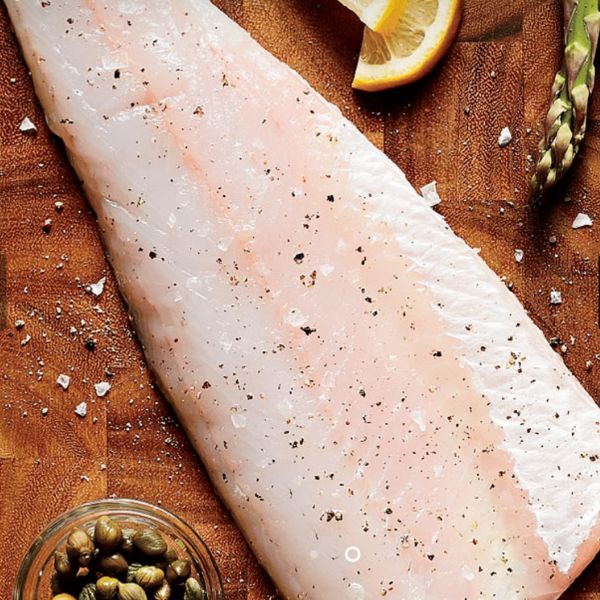
Sources: Information compiled from fisheries experts and state resources on walleye biology and angling techniques — en.wikipedia.org, wired2fish.com, fishingbooker.com, howtocatchanyfish.com, and gov.mb.ca. Each section synthesizes proven angling knowledge for U.S. walleyes across the Great Lakes and major river systems.
